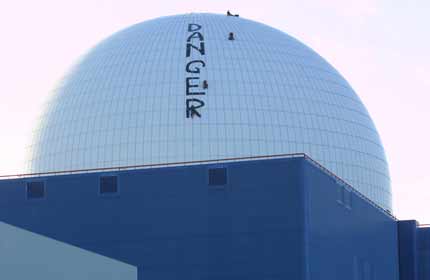
Sizewell: Volunteer climbers paint 'DANGER' down the reactor dome
On 13th January 2003, Greenpeace volunteers gained access to the Sizewell nuclear power plant complex - for the second time in six months. Their aim was to expose the failings of nuclear security around the site (and spent nuclear fuel stores) and to highlight the risk of terrorist attack.
The spectre of a major attack on a nuclear installation had been raised on September 11th 2001, when it was believed that the fourth plane (that crashed) was to have targeted the Three Mile Island nuclear plant.
The Greenpeace volunteers succeeded in challenging Sizewell's security. Several managed to climb the dome of the reactor, whilst others gained access to the reactor building through an unsecured door after scaling a ladder (unchecked by security guards).
Eleven of the volunteers have pleaded guilty to charges of criminal damage (such as painting 'danger' on the reactor dome). However, in mitigation they will plead that they performed a public service in exposing the inadequate security around Sizewell B, Britain's largest nuclear power plant.
Why the volunteers took action
The action was taken against the background of the Government's Energy Review, which threatened to propose building more nuclear power plants. The volunteers knew that nuclear security was an issue of high public importance and a significant section of the public were concerned about expanding nuclear power. A MORI poll published in 2002 showed that 72% of British people did not want nuclear power and said they preferred renewable energy sources.
The subsequent Energy White Paper deferred the building of any more nuclear power plants - citing concerns over the risk of terrorism as one of the reasons - thus indicating the breadth of concern over nuclear power and security at nuclear facilities. The volunteers believe their actions contributed to the Government's decision.
The volunteers were concerned that in October 2002, Greenpeace had entered the Sizewell plant with relative ease and believed that not enough had been done to strengthen security following the initial action. These concerns turned out to be valid, despite reassurances after October that steps would be taken, and it was easy to get in again.
The volunteers were concerned about the security of the reactor building but also about the spent nuclear fuel store. Nuclear power plants such as Sizewell B create hundreds of tonnes of spent nuclear fuel every year. Spent fuel is the most intensely hot and radioactive material on the planet. It is estimated that 230 tonnes of spent nuclear fuel is currently stored at Sizewell, with 30 tonnes more added every year.
The volunteers took the view that the weaknesses in security may in fact amount to criminal offences by British Energy - a breach of site licence amounting to breach of relevant nuclear regulation statutes (e.g. Nuclear Installations (Licencing and Security) Act 1959).
For further information, read the full briefing document, Sizewell B - terrorism and risks

